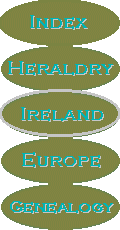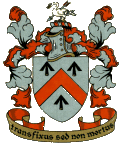Site Index
Heraldry
Ireland
Europe
Genealogy
Irish Heraldic Symbols
Irish Symbols
Irish Charges
Irish Colours
Irish Beasts
Irish Birds
Other Irish Charges
|
Irish Heraldic Symbols
Armorial bearings, or coats of arms, originated during the late medieval period
as a means of recognition on the battlefield and at tournaments. Their use
gradually extended beyond the battlefield to become the badge of identity of a
family and they were employed to attest documents, identify property and as
personal seals. The practice of bearing arms was introduced into Ireland by the Normans
in the eleventh century and was adopted by Gaelic families over the following centuries.
In addition to the basic structural elements of the coat of arms, an unlimited
variety of symbols were used to represent the history and characteristics of
individual families.
Some typical images used in Ireland were:
Red Hand - used by O'Neills and other Gaelic families and now a symbol of
the province of Ulster. Derives from Labraid Lámhdhearg, the son of the Celtic
sun-god.
The Stag - used by many Munster families derived from the ancient
Eoghanacht tribal grouping including MacCarthy, O'Sullivan, Healy and others.
The kingship myth of this group made use of the stag as the animal which
legitimised the authority of the ruling house.
Oak Tree - used by the ruling family of Connacht, the O'Conors and related
families of Flanagan, O'Beirne and many others. Derives from the ancient Celtic
reverence for the oak tree and its resultant association with kingship.
Unlike English and Scottish heraldry where a coat of arms is strictly hereditary
within a single family, Irish coats of arms were usually regarded as the property
of the sept (the tribal grouping) and hence continue to be used by those who
bear the same surname.
In the absence of concrete documentary evidence of our very early Irish family,
the family coat of arms has come to represent our link with our early Irish
ancestry and extended family. Composed of elements that represent the
history and achievements of the family, the coat of arms is seen as an
expression of our national and family identity. There are many surnames for which no coat
of arms was ever granted. It is also possible that there are surnames for which there are
two or more coats of arms available.
Irish Heraldic Charges
There are literally hundreds of different symbols (or charges) that can
appear on coats of arms. The colors that are chosen and even the
shape of the shield itself can have significance for the Family, Clan or
Sept that was to bear the arms.
The explanations below are offered as the general interpretation of what
this symbolism signifies. It is true though, that an individual coat of
arms may have a history to it that far exceeds the meanings given here
and that further investigation may be necessary.
Nevertheless, the art of heraldry has broadly assigned significance to
the symbols and they are shown below. Where particular significance
relating to a heraldic charge in an Irish context is available then a
specific note is made. Examples of the charges on Irish coats of arms
are shown where possible.
Irish Heraldic Colours
Or (Gold) - Generosity
Argent (Silver or White) - Sincerity, Peace
Purpure (Purple) - Justice, Sovereignty, Regal
Gules (Red) - Warrior, Martyr, Military Strength
Azure (Blue) - Strength, Loyalty
Vert (Green) - Hope, loyalty in love
Sable (Black) - Constancy, Grief
Tenne or Tawny (Orange) - Worthwhile Ambition
Sanguine or Murray (Maroon) - Victorious, Patient in Battle
Irish Heraldic Beasts
Lion - Fierce Courage. In Ireland the Lion represented the 'lion' season, prior to
the full arrival of Summer. The symbol can also represent a great Warrior or Chief.
(Lawlor, Dillon, Condon)
Tiger - Fierceness and valour.
Fish - Of Regal origin, one of high nature. In Ireland the Fish is associated with
the legend of Fionn who became the first to taste the 'salmon of knowledge'. The Celtic
'Otherworld' was often a place of water, a lake or sea, where would dwell Gods
represented by fish. (Roche , O'Neill )
Bear - Fierce Protection (McKee )
Wolf - Perseverance in siege or effort (Callaghan , Wilson)
Leopard - Valiant and enduring warrior (Wheeler, Price, Rice)
Horse - Readiness for duty (O'Halloran, Rush)
Bull - Valour and magnanimity (Buckley)
Boar - Fierce fighter, fights to the death. In Ireland the boar is one of the most
popular charges. The meat of the boar was considered to be food of the Celtic Gods. The
symbol of the boar was worn in battle as a charm against injury. (Hanley, Sweeney)
Boars Head - Hospitality (Pierce, Healy)
Conies (Hares and Rabbits) - Peace-loving (Gaffney)
Fox - Wise defence, wisdom
Dog (Talbot, Greyhound) - Courage, fidelity, loyalty (Allen, Gaffney)
Dolphin - Affection, charity (O'Regan)
Tortoise - Invulnerability (Conlon)
Griffin - Valiant soldier - to the death, Vigilance. In Ireland the worship of the
sun in pre-Christian times was often represented by the Griffin. It later became a symbol
of gold - 'yellow light'. (Lowe, Griffin)
Dragon - Valiant defender (McGillycuddy)
Stag, Buck or Deer - Skillful, Politic, lover of harmony. In Ireland the Stag was one
of the most ancient of charges and was regarded as the most handsome. The Stag represents
the very ancestors of the Celtic race. (Green, Hennessy)
Snake. - Wisdom. In Ireland the Snake was a symbol of fertility and renewal, and
also, because of its forked tongue, was associated with lightning and the sun. (Donovan, Hayes, O'Dea)
Irish Heraldic Birds
Martlet/Swallow - One who has been disposessed of land. Sign for fourth son. In
Ireland the Martlett was the bird of perpetual movement. (McGill, McCoy)
Eagle - Protector, a person of action, noble nature, power, strength. In Ireland the
eagle, along with other birds, was regarded as one of the 'demons of the air' and was
thus a very popular and powerful charge. (Harrison, Dunne)
Peacock - Beauty, pride
Swan - A musical person, poetry, harmony. In Ireland the Swan was regarded as the
bird that bore the spirit of a dead Celtic Chieftain sway to the next life. (Sinnott)
Dove - Love, Peace. In Ireland the Dove was regarded as the bird of God. (Nash, Sheehan)
Further Irish Heraldic Charges
Escallop Shell - Successful commander, one who has made long journeys (Ellis, Graham)
Heart - Sincerity, truthfulness, charity (Adams)
Hand - Faith, sincerity, justice. In Ireland the open hand was often used as a means
of communicating through the ancient language known as 'Ogham'. The open hand may have
also signified the sun. (Cullen, Mangan)
Red Hand - The mark of a Baronet. In Ireland the open red hand is often a symbol of
the Province of Ulster. (Breen, McKeown)
Arm - An industrious person (Smith)
Arm with armour - A person fit for high deeds (McNally, Armstrong)
Human Head - Honour
Crown - Regal or senior authority, heavenly reward (Ward, Humphreys)
Finger Ring or - Annulet, Fidelity. Sign of the fifth son. (Fitzgibbon, Young)
Lozenge - Honesty, constancy, noble birth (Lavin)
Anchor - Hope (Allen)
Ship, Lymphad, Boat, Galley - Hope, a sea-faring tradition (Campbell, McDonald, O'Leary)
Axe - Military duty (McCourt)
Tower - Grandeur, society, wealth (Kelly, O'Shaughnessy)
Cross - Of Christian significance. May also refer to families who engaged in the
Crusades. (Devlin)
Cross Moline - Eight son (Scully)
Label - First son
Cushions - A mark of authority (Johnston, Redmond)
Estoile (a star with wavy points) - God's goodness, superiority (Curry)
Mullet (5-pointed Star) - Divine quality bestowed by God. Sign of the third son.
(Cunningham, Murray)
Sun - Glory, Splendour, Authority. In Ireland the Celts worshiped the sun as well
as other celestial bodies. The invocation of the sun would be the same as invoking truth.
(Brady)
Crescent - Hope of glory, one who has been enlightened. Sign of the second son.
(Waldron, Mangan)
Hunting Horn - A person of high or noble pursuits (Hunter, Close)
Arrows, Arrow-Heads - Military readiness, affliction (Cooney, Hanley)
Spear - Devotion to honour, knightly service
Spear-head/Pheons - readiness for battle (Sharkey)
Horse-Shoe - Good Luck (Sexton, Ferris)
Maunch/Sleeve - A symbol of devotion, victory in tournament (Croke)
Chain - A mark of honour and obligation (Kelly)
Helmet - Wise defence (Kennedy, Traynor)
Torch - Zealousness, a signal service (Smith)
Book - if open: Manifestation, if closed: Counsel (King)
Passion Nails - Poignant suffering (Logan)
Bell - Power to disperse evil (Porter)
|

|


